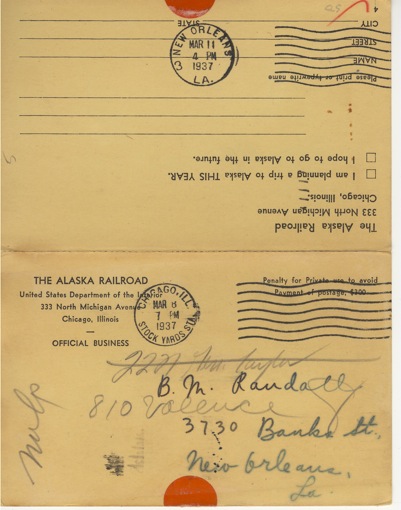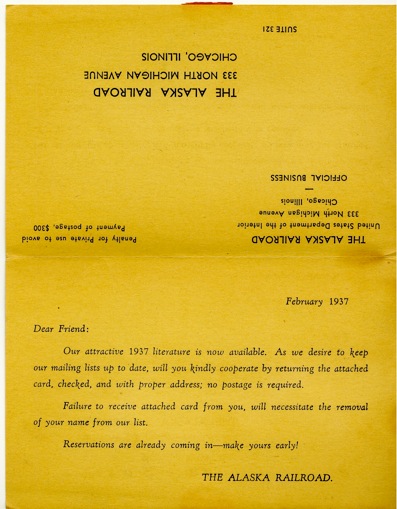

Penalty Reply Card
 |
 |
Surveying for what we now know as the Alaska Railroad began in June 1902—a way to reach the interior. After a series of fits and starts, two commissions, reports, and three companies, the railroad opened in 1923, with President Warren G. Harding driving a golden spike at North Nenana. By the late 1930s, the railroad was 551 miles, including 471 miles on the mainline. (More information is found in the marvelous "A Guide to Alaska" by Merle Colby, sponsored by one of the Roosevelt Administration's jobs projects, the Federal Writers Project and the Alaska territorial government. It can be found in many libraries.)
The railroad achieved one of its goals of opening up the interior, and one of its construction camps grew up to be Anchorage.
By the late 1930s, the railroad, owned by the Department of the Interior, had an office in Seattle, presumably to help coordinate both freight and tourism.
The illustration is of a penalty reply card---that is, an official card, which, if used for private purposes, would result in a penalty fine of $300---shows that the railroad also had an office in Chicago.
The office mailed the card to potential tourists, offering them "our attractive 1937 literature," and asking recipients to confirm they still wanted to be on the mailing list.
But why a Chicago office? One Alaska Railroad historian hypothesized to me that the Chicago office also addressed issues of interline freight. Moreover, the railroad was, in 1935, active in promoting and serving the transit needs of agricultural colonists moving from the Midwest to the Matanuska Valley.
(For those of you who live elsewhere and are touristing in Alaska, I heartily recommend a visit to Palmer, which was the center of a New Deal agricultural colony. It has a great museum, wonderful historic buildings, and a marvelous B&B, the Colony Inn, in an old teachers' dorm. Palmer is also home to the state fair. Unfortunately, Palmer is the town adjacent to Wasilla, which is somewhat of the opposite of Palmer, both from an architectural and political perspective.)
This particular reply card was returned to railroad, the addressee in New Orleans having moved.
Page created 9/4/10 and last updated 9/4/10